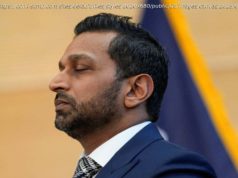The newly confirmed justice can become an embittered partisan—or he can surprise people.
No Supreme Court Justice has ever arrived under a darker cloud than the one over Brett Kavanaugh. Americans believe the women accusing him of sexual assault and abuse 52 percent to 38 percent. Many also think he lied to the Senate. His angry confirmation testimony was so injudicious that he had to write a mea culpa op-ed in the Wall Street Journal promising to do better if he made it on the Court.
The opposition to him was equally extraordinary. More than 2,400 law professors and one retired justice, John Paul Stevens, declared him unfit. Americans did not want him confirmed, 51 percent to 41 percent, and his Senate margin was the closest since 1881. The only nominee in decades to rival him in unpopularity, Robert Bork, was not confirmed. The only justice in the modern era to compare to him in controversy, Abe Fortas, resigned.
Justice Kavanaugh is often compared to Justice Clarence Thomas, but the scandal he brings to the Court is far worse. Thomas was accused of sexual harassment, not criminal sexual assault. More Americans believed Thomas was innocent, and they supported his confirmation by 2-1.
The Court itself will welcome Kavanaugh. The four conservative justices have waited years for a reliable fifth vote and they no doubt believe he was badly treated. The liberals are already adhering to the Court’s tradition of collegiality. When he was sworn in Saturday, Justices Ruth Bader Ginsburg and Elena Kagan attended.
He will have no problem hearing any case he wants. Kavanaugh—who lashed out at “left-wing opposition groups” in his opening statement—may be asked to recuse himself in matters involving liberal legal groups, sexual assault, or President Trump. But he will be free to do as he wishes. Recusal is up to the justices, and they rarely recuse. The late Justice Antonin Scalia famously refused to recuse himself in a case involving his friend Vice President Dick Cheney after they had just gone duck hunting together.
Outside the Court, though, things will be rougher. If Democrats win the House—and polls give them about a 75 percent chance—Rep. Jerrold Nadler (D-N. Y.), who is in line to be Judiciary Committee chairman, has promised an investigation. Kavanaugh would face far tougher grilling than at his Republican-controlled confirmation hearing. There could also be a long list of hostile witnesses. Cue the media circus. There is a real chance the House could impeach, though it is unlikely two-thirds of the Senate would vote to convict.
Kavanaugh may also have difficulty moving through the larger world. He said himself that he may no longer be able to coach girls’ basketball, and it is hard to imagine him visiting elite law schools any time soon without facing massive protests. He could find it hard to keep his position in Washington society if angry members of the public criticize him everywhere he goes.
There are predictions that Kavanaugh will become the next Thomas, who has been dubbed “The Angriest Justice.” Thomas has staked out a position on the Court’s far right and he has remained fiercely loyal to the conservative groups that stood by him. He clearly seems to harbor rage toward his confirmation-time antagonists—in his memoir he compared the “left-wing zealots” he encountered in Washington unfavorably with the Ku Klux Klan.
If Kavanaugh follows a similar path, he will become an embittered partisan, joining the Court’s right-wing fringe, defiantly rejecting motions to recuse, running into the warm embrace of the conservative Federalist Society—and writing a vitriolic memoir. This could not possibly be an appealing prospect for him on a personal level, and it would be a significant blow to the Court’s standing if two of its nine members were wounded, grudge-settling ideologues.
There is, however, another option. Kavanaugh cannot undo the past, but he can recognize the damage his presence poses to a vital institution. And he can dedicate himself to minimizing it. His guiding light should not be Thomas, but his pre-confirmation vow in his Wall Street Journal op-ed to be “even-keeled, open-minded, independent and dedicated to the Constitution and the public good.”
He could start with recusals. It undermines confidence in the Court when justices rule in cases where there is an appearance of bias, and that will particularly be true of Justice Kavanaugh, who not only delivered a partisan tirade to the Senate but ominously declared that “what goes around comes around.” He could lead his fellow justices to recuse more often, and to explain why they are doing so.
Kavanaugh could also persuade his colleagues not to attend partisan gatherings—like the one Justice Neil Gorsuch attended last year at the Trump International Hotel, funded by the libertarian Charles Koch Foundation. And he could convince them to stop accepting emoluments from people interested in how the Court rules. (Scalia died while on a junket to a luxury ranch in Texas, in a room he was not paying for.) The partisan gatherings give an impression that the justices represent ideological camps—especially when they mainly attend events on only one side of the political spectrum. The emoluments look corrupt. There is no ethics code that applies to the Court, but Kavanaugh could make it his mission to persuade his colleagues to improve their ethics of their own volition.
Kavanaugh could also advocate for television cameras in the Court, something his colleagues have long resisted. Rather than nurse resentments over how he came across on television, he could argue that the American public has a right—a duty, in fact—to monitor the workings of the nation’s highest court. And he could invite the public to watch him be, as he promised in his op-ed, better than he came across in his Senate testimony.
The best way for Kavanaugh to prove that he is “even-keeled, open-minded, independent,” and not a mere ideological agent, would be to work with Chief Justice John Roberts and Justices Kagan and Stephen Breyer to build a non-extreme, unpredictable center of the Court. The public is expecting a lot of 5-4 hardline conservative rulings in the most important cases.






